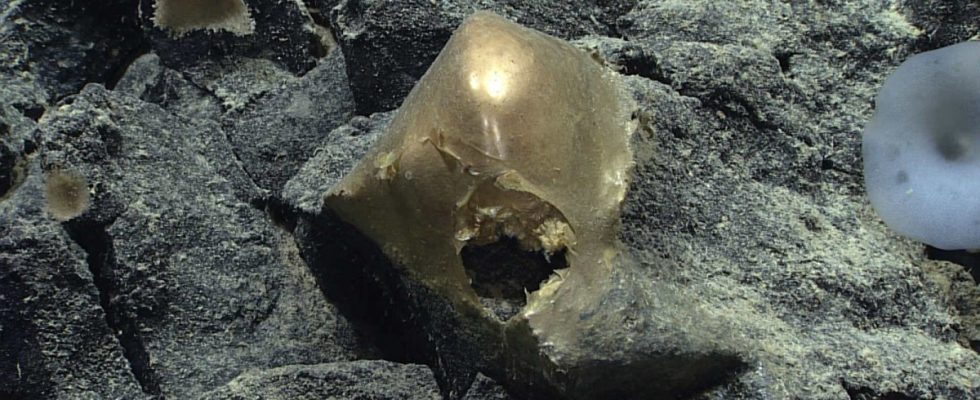Is it a dead sponge? A previously unknown deep sea creature? Or even the egg of an alien? During a deep-sea expedition off Alaska, marine biologists from the US National Meteorological and Oceanographic Administration (NOAA) have found a mysterious structure that looks like an egg hidden under a blanket and shimmers golden. The researchers are at a loss: What could this be?
All that is clear so far is that the “Golden Egg”, which grew on a rock at a depth of 3,300 meters, has a diameter of around ten centimeters and is of biological origin. As the diving robot, the researchers from their ship NOAA Oceanos Explorer out of control, carefully made a small cut in the egg, nothing happened. But you could see that the find was also gold on the inside. The egg has a small hole or crack at the bottom: Did something slip out?
“It could actually be an egg shell,” suspects Autun Purser from the Alfred Wegener Institute in Bremerhaven, who is working with the research ship Polaris currently on an expedition to the North Pole. “Maybe there are several eggs in it too.” But what kind of animal? “Inside you can see a kind of honeycomb structure,” says Purser. “This is typical of snail eggs.” It could also possibly be octopus eggs. “But I’m not sure how golden they are,” says Purser.
On board the ship, the mysterious structure retained its shape
The strange structure retained its shape when the diving robot used a gripper arm to detach it from the rock to which it had grown, suck it up and bring it on board the expedition ship. But even upon closer inspection, the egg, which took on a more brownish color on board, remained a mystery to the expedition participants. So far they can’t even say whether it’s a previously unknown creature, an unknown life stage of an already known creature, or something that a creature made and then left behind. “We probably won’t know more until we get this object to a laboratory on land,” said expedition coordinator Sam Candio, according to a NOAA press release.
Researchers found this series of holes on the bottom of the Atlantic north of the Azores in 2022.
(Photo: NOAA Ocean Exploration/Imago/Cover Images)
Just last year, during another deep-sea expedition north of the Azores, NOAA researchers discovered mysterious traces on the ocean floor: a dead straight line of rectangular holes that suddenly broke off after about two meters. The holes look like they were made by humans, but are probably from a deep-sea creature. Other strange traces on the seabed are closer to a solution. Huge circles in the deep sea are probably whale headprints. This is thought to be because scientists in shallower waters have observed whales pushing their heads into the sand and moving them back and forth to get rid of parasites. This has not yet been observed in the deep sea, but the prints there look very similar.
The mystery of circular tracks that look as if they were drawn with a giant compass has also been solved. They are created by the tongue of a worm, up to one and a half meters long, which sits in the sediment and licks the soil around it in a circular motion.

